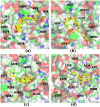Understanding the basis of drug resistance of the mutants of αβ-tubulin dimer via molecular dynamics simulations
- PMID: 22879949
- PMCID: PMC3413672
- DOI: 10.1371/journal.pone.0042351
Understanding the basis of drug resistance of the mutants of αβ-tubulin dimer via molecular dynamics simulations
Abstract
The vital role of tubulin dimer in cell division makes it an attractive drug target. Drugs that target tubulin showed significant clinical success in treating various cancers. However, the efficacy of these drugs is attenuated by the emergence of tubulin mutants that are unsusceptible to several classes of tubulin binding drugs. The molecular basis of drug resistance of the tubulin mutants is yet to be unraveled. Here, we employ molecular dynamics simulations, protein-ligand docking, and MMPB(GB)SA analyses to examine the binding of anticancer drugs, taxol and epothilone to the reported point mutants of tubulin--T274I, R282Q, and Q292E. Results suggest that the mutations significantly alter the tubulin structure and dynamics, thereby weaken the interactions and binding of the drugs, primarily by modifying the M loop conformation and enlarging the pocket volume. Interestingly, these mutations also affect the tubulin distal sites that are associated with microtubule building processes.
Conflict of interest statement
Figures







Similar articles
-
Structural basis for drug resistance conferred by β-tubulin mutations: a molecular modeling study on native and mutated tubulin complexes with epothilone B.J Biomol Struct Dyn. 2015;33(12):2530-40. doi: 10.1080/07391102.2015.1063455. Epub 2015 Jul 17. J Biomol Struct Dyn. 2015. PMID: 26081685
-
Structural insight into the mechanism of epothilone A bound to beta-tubulin and its mutants at Arg282Gln and Thr274Ile.J Biomol Struct Dyn. 2012;30(5):559-73. doi: 10.1080/07391102.2012.687522. Epub 2012 Jun 25. J Biomol Struct Dyn. 2012. PMID: 22731768
-
Comparative binding energy (COMBINE) analysis supports a proposal for the binding mode of epothilones to β-tubulin.ChemMedChem. 2012 May;7(5):836-43. doi: 10.1002/cmdc.201200065. Epub 2012 Mar 16. ChemMedChem. 2012. PMID: 22431398
-
Epothilone B and its analogs - a new family of anticancer agents.Mini Rev Med Chem. 2003 Mar;3(2):149-58. doi: 10.2174/1389557033405269. Mini Rev Med Chem. 2003. PMID: 12570848 Review.
-
3D QSAR models of interactions between beta-tubulin and microtubule stabilizing antimitotic agents (MSAA): a survey on taxanes and epothilones.Curr Top Med Chem. 2004;4(2):203-17. doi: 10.2174/1568026043451465. Curr Top Med Chem. 2004. PMID: 14754454 Review.
Cited by
-
Exploring tubulin-paclitaxel binding modes through extensive molecular dynamics simulations.Sci Rep. 2025 Mar 11;15(1):8378. doi: 10.1038/s41598-025-92805-z. Sci Rep. 2025. PMID: 40069250 Free PMC article.
-
Exploring the Origin of Differential Binding Affinities of Human Tubulin Isotypes αβII, αβIII and αβIV for DAMA-Colchicine Using Homology Modelling, Molecular Docking and Molecular Dynamics Simulations.PLoS One. 2016 May 26;11(5):e0156048. doi: 10.1371/journal.pone.0156048. eCollection 2016. PLoS One. 2016. PMID: 27227832 Free PMC article.
-
A Novel Y319H Substitution in CYP51C Associated with Azole Resistance in Aspergillus flavus.Antimicrob Agents Chemother. 2015 Oct;59(10):6615-9. doi: 10.1128/AAC.00637-15. Epub 2015 Jul 27. Antimicrob Agents Chemother. 2015. PMID: 26248359 Free PMC article.
-
In silico Investigations of the Mode of Action of Novel Colchicine Derivatives Targeting β-Tubulin Isotypes: A Search for a Selective and Specific β-III Tubulin Ligand.Front Chem. 2020 Feb 21;8:108. doi: 10.3389/fchem.2020.00108. eCollection 2020. Front Chem. 2020. PMID: 32154219 Free PMC article.
-
Benzimidazole resistance-associated mutations improve the in silico dimerization of hookworm tubulin: An additional resistance mechanism.Vet World. 2024 Dec;17(12):2736-2746. doi: 10.14202/vetworld.2024.2736-2746. Epub 2024 Dec 6. Vet World. 2024. PMID: 39897360 Free PMC article.
References
-
- Conde C, Caceres A (2009) Microtubule assembly, organization and dynamics in axons and dendrites. Nat Rev Neurosci 10: 319–332. - PubMed
-
- Verhey KJ, Gaetig J (2007) The tubulin code. Cell Cycle 6: 2152–2160. - PubMed
-
- Jordan MA, Wilson L (2004) Microtubules as a target for cancer therapy. Nature Rev Cancer 4: 253–265. - PubMed
-
- Perez EA (2009) Microtubule inhibitors: differentiating tubulin-inhibiting agents based on mechanism of action, clinical activity, and resistance. Mol Cancer Ther 8: 2086–2095. - PubMed
Publication types
MeSH terms
Substances
LinkOut - more resources
Full Text Sources

